The iPad Air Review
by Anand Lal Shimpi on October 29, 2013 9:00 PM ESTiPhone to iPad: CPU Changes
Although the iPad Air uses the same A7 from the iPhone 5s (and M7 motion coprocessor), there are a few minor differences that do lead to better performance.
At a high level we’re still talking about two 64-bit Apple Cyclone cores with 128KB L1s (64KB I$ + 64KB D$) per core, a shared 1MB L2 cache and a 4MB L3 cache that services the entire SoC. Apple increased CPU frequency from 1.3GHz to 1.4GHz in the iPad Air, a mild increase but in line with what we’ve seen from previous iPad designs. That’s the first impact on performance - a 7.69% increase in CPU frequency.
The second impact on performance is something I only noticed while digging around under the hood of the A7. It seems like the implementation in the iPad Air can, for whatever reason, hold more instructions in flight (over 20% more) than the A7 in the iPhone 5s. It’s unclear to me whether the A7 in the iPad is configured any differently via firmware/microcode or if perhaps we’re looking at a slightly different revision of the core, but the delta was repeatable in my testing.
The third, and likely biggest change impacting the iPad Air’s implementation of the A7 is the additional thermal headroom afforded by the larger chassis. I’m not going to go into details on exactly what this next test does (unfortunately we’re going to occlude some of the low level work that we do in light of all of the benchmark cheating going on), but we’re looking at a curve of performance vs. time for a particularly power heavy mix of code. We’re running the same exact code on both the iPad Air and iPhone 5s here, the only real difference is the size of the chassis:
You can see the 5s throttles back its CPU frequency to about 1GHz after the 2 minute mark. The crazy thing is that until that point the 5s manages to run at full frequency without so much as a hiccup for two full minutes, running an incredibly power hungry task. Given that most iOS apps aren’t this power intensive for such a sustained period of time, iPhone 5s users should almost always see the A7 running at a full 1.3GHz. Pretty crazy.
The iPad Air by comparison shows much more controlled behavior. Early on in the test we see a 7.7% performance advantage, which lines up perfectly with the iPad Air’s 7.7% CPU frequency advantage. By the end of the test the iPhone 5s has throttled to 900MHz, while the iPad Air drops to around 1.2GHz. At this point the iPad Air’s performance advantage grows to almost 40%.
CPU Performance
I've gone through our standard set of cross-platform browser based benchmarks to place the iPad Air's performance in perspective. As I mentioned in our 5s review, I don't know that there are many (any?) applications on iOS 7 that can really take advantage of all the A7 has to offer. There's definitely a ton of headroom left in the design. What's particularly exciting is when the A7 ends up in n-1 or n-2 iOS devices and it becomes the minimum developer target going forward.
I won't go through all of the results here again, but it's safe to say that the iPad Air is the fastest ARM based tablet on the planet at this point.
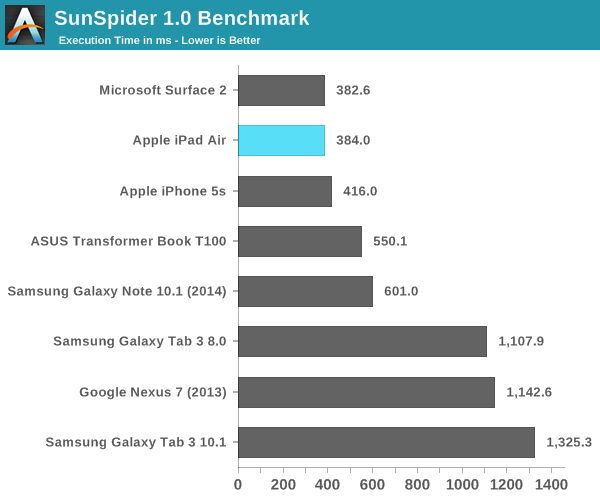
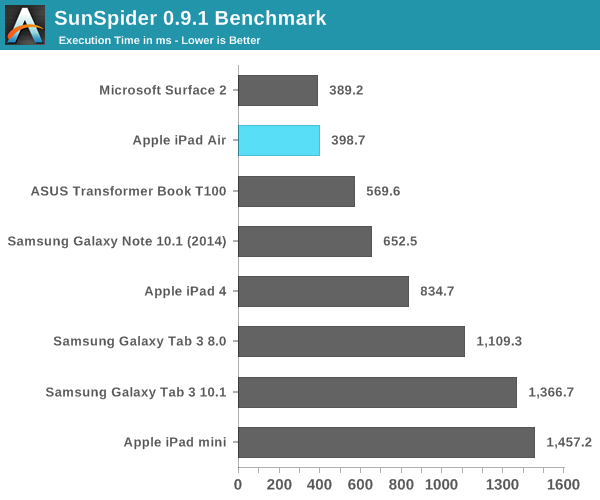
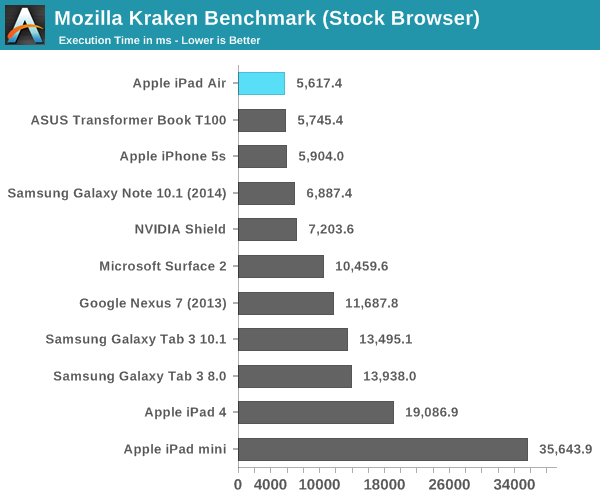
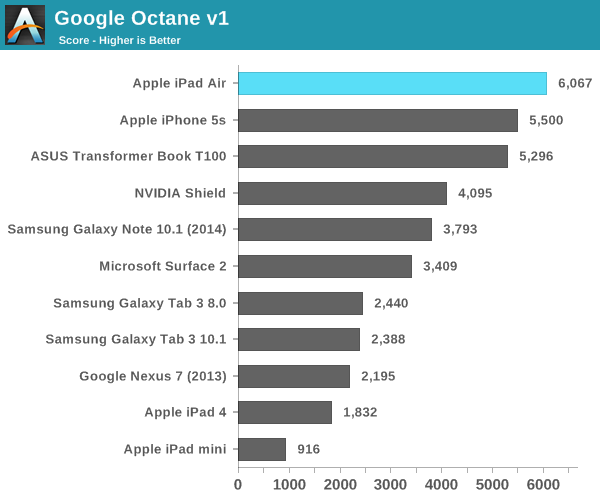
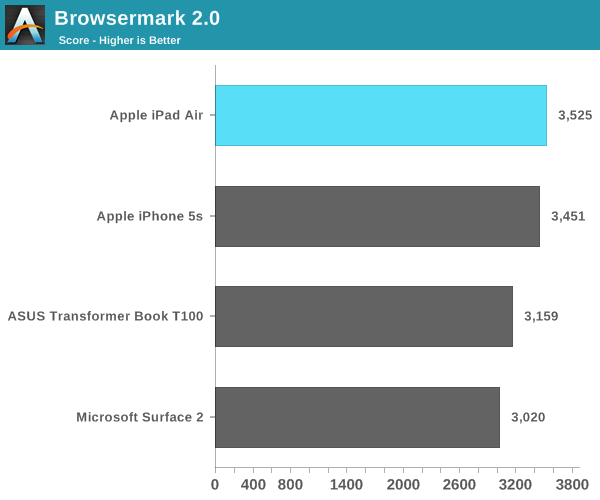

A7 Power Consumption
I’ll get to battery life in a bit, but I’ve been curious about the dynamic range of power consumption offered by Apple’s new A7 SoC. On the one hand we’re dealing with a lower power process (28nm vs. 32nm), but on the other hand Apple’s Cyclone cores can clearly draw more power given how beefy the architecture is this round. Apple frowns upon review sample dissection so I had to turn to a less scientific method of external platform level power measurement. The fidelity of the numbers here aren’t all that great but it’s better than nothing.
For the first test I measured platform power consumption during a Kraken run:
I purposely started measuring before the benchmark so I could get an idea of idle power consumption. The iPad Air consumes roughly 72% of the idle power as the iPad 4, both running at the same brightness. Here we’re not just seeing the A7’s advantages but also things like lower display power.
Focusing on the load portion of the measurement we see that both the new iPad and old iPad consume the same total power in this test. I suspect the A7 is drawing more power than the A6X, but it’s masked by a lower power display. Given how much faster the iPad Air is, Apple’s latest tablet features far lower overall task energy than the outgoing iPad 4. This is probably both the best case scenario for the iPad Air and the most likely case as well.
For kicks I wanted to see just how much power I could get the iPad Air to draw. Here I’m looking at platform power during our mini-power-virus test from above:
How’s that for dynamic range? Almost 12W running all out, but around half that in what we’d normally consider to be a stressful CPU test. I couldn’t get any actual applications/games on the iPad Air to behave like this so the results above are purely academic (for now). A quick run through GFXBench 2.7’s T-Rex HD test confirms that even pushing the GPU won’t hit these numbers. The max I saw running T-Rex offscreen was ~6W, and turning to an actual game (Infinity Blade 3) the iPad Air pulls less than 5W.


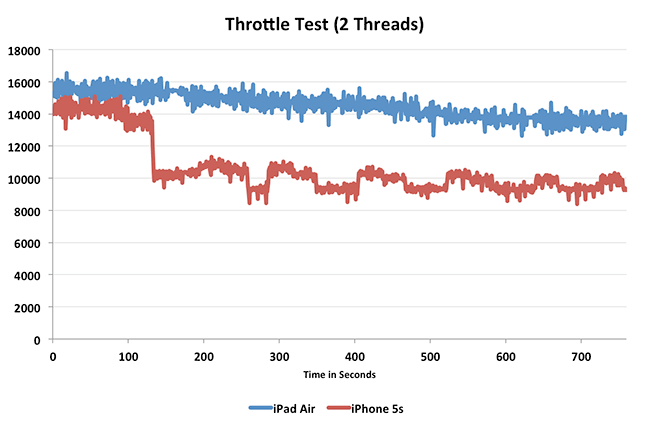
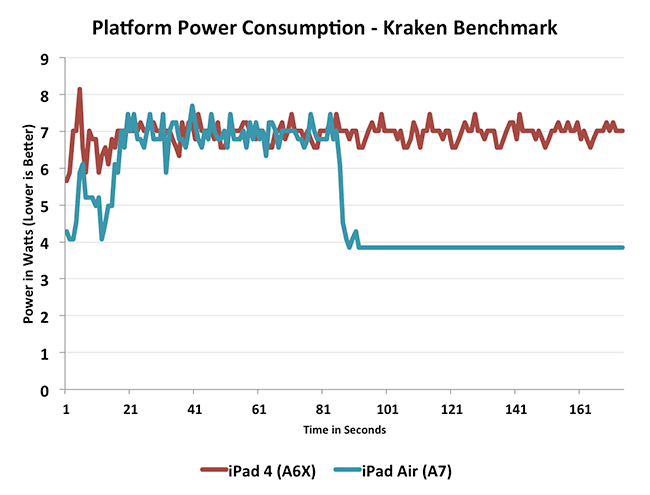
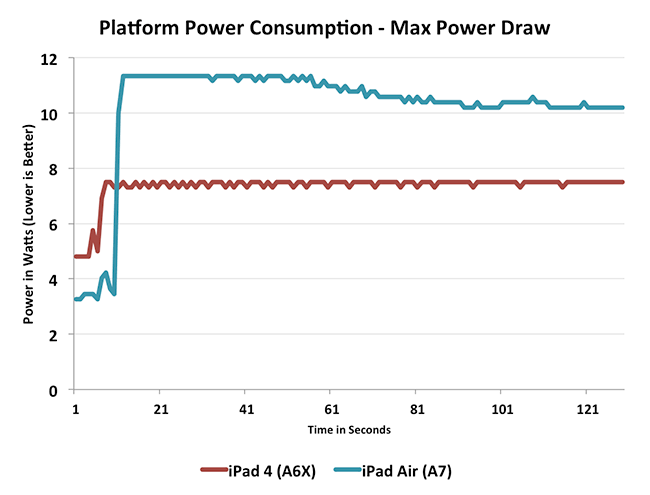








444 Comments
View All Comments
Wilco1 - Thursday, October 31, 2013 - link
The "cheats" do not prevent thermal throttling down at all - they simply switch to maximum frequency immediately. The issue is that many of the popular benchmarks run for such short periods (~10 milliseconds) that the DVFS has no time to switch to maximum frequency. A long running benchmark always runs at the maximum frequency.KoolAidMan1 - Wednesday, October 30, 2013 - link
CPU throttling for thermal reasons, one of the most common functions in CPUs and GPUs, is the exact opposite of an application boosting clock speed based on triggers from specific benchmarks and applications in order to game performance numbers.Blown away by the lack of thinking in the comments
KPOM - Wednesday, October 30, 2013 - link
Maybe because he had previously commented that Apple, Motorola, and Google don't cheat on benchmarks.Graag - Wednesday, October 30, 2013 - link
Look, lilo, we all know that you're an anti-Apple shill based on your posting history, so it's probably too much for you to actually understand what you're writing.The kind of cheating you are incorrectly remembering occurred when a device that *usually* throttled its frequency to save battery power did not throttle its frequency when it detected that a benchmark program was running.
Obviously, that's not what's going on here.
tential - Wednesday, October 30, 2013 - link
Dunno where all the hate is on this review.I read the Engadget review first, and was meh about it. I come here and I read a full hardware review. It's just amazing the amount of effort that goes into these reviews.
My only complaint is that anandtech doesn't review more products! Haha. I'd really like to see some ultrabook/lower end laptops reviewed. Some more routers as well. This is a great review though, I realy don't even want to waste my money now on a new tablet/phone when apple seems to have went full steam ahead to destroy competition in performance. it's too bad the average consumer knows nothing about this stuff though.
tential - Wednesday, October 30, 2013 - link
To further elaborate since people are saying this review favors Apple. The review of the Nexus 7 was also VERY NICE in terms of what google did. Anandtech is praising apple in this review, but they praise companies that do a good job period. I don't hitnk this review favors apple at all. It does point outa number of short comings as well.I think the Ipad Air is great, but Google NExus 7 definitely holds its own at the price point given and clearly there is an advantage for Apple with it's focus on its own ARM processor development because they develop their own processor for their own new OS while SnapDragon and Google work independently (to my knowledge at least).
Streamlined - Wednesday, October 30, 2013 - link
It's because the web is full of paid shills who post comments for money from Apples competitors.KoolAidMan1 - Thursday, October 31, 2013 - link
Its because tech forums are filled with paid shills from Apple's competitors and anti-Apple fanboys who will jump through as many mental hoops as possible to deny any positives their products and ecosystem hasprashy21 - Wednesday, October 30, 2013 - link
Anand,A very nice and detailed review ( as always ).
I have couple of points
"Touch ID" should have been part of it ( it's deal breaker for me to upgrade my 3rd gen iPad ).
As you pointed out 32GB should be norm now as Apple charges premium for their product.
azazel1024 - Wednesday, October 30, 2013 - link
Good overall review.However, I have to disagree a lot with the comment on speaker location.
Yes, you have trade-offs between both on top or bottom if held in portrait postion or one on top one on the bottom in portrait position. However, I do think Apple choose poorly with this. I can't believe I am the only one who pretty much watches movies 100% in landscape postion. On top of that probably 90% of my gaming is in landscape with the rare exception of a game that is only portrait (cut the rope for example). Probably more than 75% of my music listening is also in landscape (either because it is on a stand in landscape, or I am browsing the web in lanscape).
So for me personally, and I'd bet most other users, the times they'd be using the speakers, they are going to be using their iPad in landscape mode...which means they get no stereo.
The RF window could have been relocated to what is the side in portrait mode, or top when in landscape to accomodate repositioning of the speakers. Well, it should have anyway, though it might not be feasible with the internal layout of battery and boards.
One of those things that interests me in the T100 (other than, well, full windows) is proper placement of the speakers for stereo sound when I'd actually be using the speakers 90+% of the time (and better speakers it sounds like?).
Apple has kind of lost me through no real fault of their own though. The iPad was amazing when it first came out. The iPad 2 was great. The Retina iPad 3 had some big trade offs but an amazing screen (weight and charging time). The iPad 4 is...uh...an increment. The Air looks great and seems to be a huge improvement over the iPad 3/4.
The problem is that others have improved their game. Android has gotten much better as an OS over the intervening years and OEM/ODMs have really stepped up their game in Android tablet designs.
Windows 8 was an okay touch OS. 8.1 was a better (if not great, an okay) touch OS. Intel finally came out with a good enough (and in some ways, damned good) x86 Atom processor in Silvermont/Bay Trail.
iOS just doesn't have productivity potential in the areas I am interested in and zero compatibility with the productivity apps I use on the desktop/laptop (Lightroom being one of the main ones). For general content consumption, Android is cheaper with some rather good designs. Windows tablets, with the T100...are also cheaper and so much more productivity potential when needed.
I'll keep my iPhone, thank you very much. For a phone and phone OS, iPhones and iOS are great IMHO. For a tablet though, now that the hardware has continuously improved, I feel like it can finally deliver on productivity like I've always wanted it to. So an "appliance" operating system is no longer appropriate to me in a tablet (well, not a tablet I'd buy). The hardware is great, but the OS not so much anymore (for a tablet).